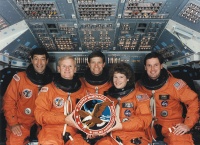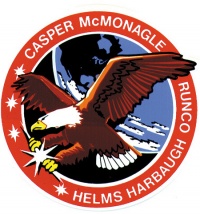STS-54
From The Space Library
 | |
| Organization | NASA-OfficeofSpaceFlight(UnitedStates),NASA-OfficeofSpaceScienceApplications(UnitedStates) |
|---|---|
| Mission type | Astronomy,Human Crew,Life Science,Microgravity |
| Launch date | January 13, 1993 |
| Launch vehicle | Space Shuttle |
| Carrier rocket | {$Carrier Rocket} |
| Launch site | Cape Canaveral, United States |
| COSPAR ID | 1993-003A |
| Mass | {$Mass} |
| Experiments | Here |
| Alternate Names | 22313 |
| Nominal Power | {$Nominal Power} |
| Additional Information | Here |
| PDMP Information | Here |
| Telecommunications Information | Here |
| Data Collection | Here |
| Payload Mass Up | 21156.0 kg |
The STS 54 mission was the third flight of the orbiter Endeavour and was used to launch the sixth satellite in the Tracking and Data Relay Satellite (TDRS) series, TDRS-F. In addition, STS 54 carried a shuttle bay instrument called the Diffuse X-ray Spectrometer, or DXS, to make observations of the diffuse x-ray background in the Milky Way galaxy. Finally, several mid-deck experiments were performed, including: (1) the fourth flight of the CHROMEX series, this time studying the developmental and physiological processes influencing seed production in microgravity; (2) the second flight of the Commercial Generic Bioprocessing Apparatus (CGBA), a collection of 28 separate commercial investigations in biomedical testing and drug development, controlled ecological life support systems, and agricultural development and manufacture of biological-based materials; (3) the second flight of the Physiological and Anatomical Rodent Experiment (PARE), investigating the short-term effects of microgravity on the size, strength, and stamina of skeletal muscles; and, (4) the first flight of the Solid Surface Combustion Experiment (SSCE), to study the physical and chemical mechanisms of flame propagation over solid fueternally-imposed airflows.

